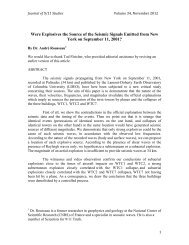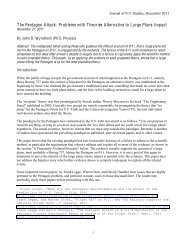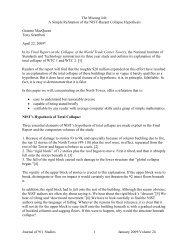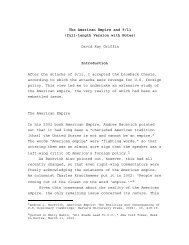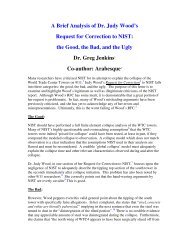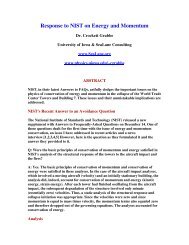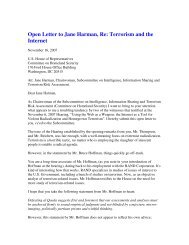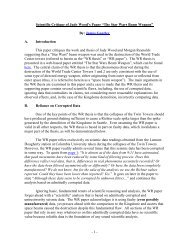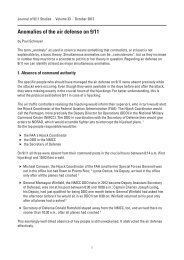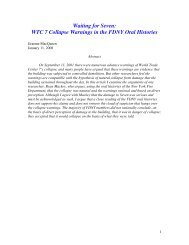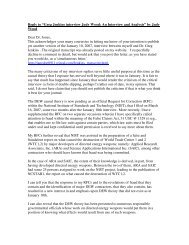interview with dr. judy wood and dr. greg jenkins - Journal of 9/11 ...
interview with dr. judy wood and dr. greg jenkins - Journal of 9/11 ...
interview with dr. judy wood and dr. greg jenkins - Journal of 9/11 ...
You also want an ePaper? Increase the reach of your titles
YUMPU automatically turns print PDFs into web optimized ePapers that Google loves.
JW: It’s missing, <strong>and</strong> this snowball can’t account for it all. Where’d it go?<br />
GJ: Well, I’m not sure if that accounts for it all. I saw a lot <strong>of</strong> debris go down from that<br />
building, <strong>and</strong> based on that picture it seems plausible to me that most <strong>of</strong> the building is<br />
<strong>with</strong>in that debris.<br />
Audience: Isn’t there a pyroclastic flow that happened?<br />
JW: It hasn’t got down to any point to flow anywhere yet... It’s just…this material here is<br />
all that’s left, except for what’s going up.<br />
Audience: So is the pyroclastic flow included in the debris moving out?<br />
JW: I wouldn’t really call this a pyroclastic flow. I would call this explosions. This part<br />
<strong>of</strong> the building is being exploded out.<br />
Audience: You were both disagreeing on the amount <strong>of</strong> debris, how far it went away. I<br />
just wondered if you include that in the debris moving away from the towers?<br />
JW: I’m saying there’s not much building left. I’m not saying exactly what radius it goes<br />
to. You have inch deep dust a mile or two away. Do you count that? It gets spread all<br />
over the place. But what I see in this picture is we don’t have much building left, <strong>and</strong> it<br />
has yet to hit the ground.<br />
Comment: It depends upon how you define your distribution, so yes, you can define a<br />
radius <strong>and</strong> decide whether you need to include the dust scattered a mile or two away. The<br />
vast majority <strong>of</strong> the building, however, fell well <strong>with</strong>in an area defined by a radius 6<br />
times its footprint. 40<br />
GJ: OK. (Searches through papers)<br />
JW: I’m glad you brought this. This is my favorite picture.<br />
GJ: Excellent. I’m glad. Well, I guess that accounts for why you put it on your website.<br />
OK. So, for any kind <strong>of</strong> beam weapon to annihilate the steel or anything like that, you<br />
would have to pump in a certain amount <strong>of</strong> energy to do that.<br />
JW: It depends on what wavelength you use.<br />
GJ: No. The energy doesn’t depend on the wavelength.<br />
Comment: The energy required to vaporize steel does not depend upon the form <strong>of</strong><br />
energy. The form <strong>of</strong> energy will lead to differing degrees <strong>of</strong> loss which will increase the<br />
minimum energy requirements, but the amount <strong>of</strong> energy required to vaporize steel<br />
remains the same.



